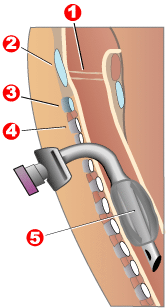
Photo from wikipedia
Objectives To evaluate the association of tracheostomy timing with all-cause mortality in patients with mechanical ventilation (MV). Method It’s a retrospective cohort study. Adult patients undergoing invasive MV who received… Click to show full abstract
Objectives To evaluate the association of tracheostomy timing with all-cause mortality in patients with mechanical ventilation (MV). Method It’s a retrospective cohort study. Adult patients undergoing invasive MV who received tracheostomy during the same hospitalization based on the Medical Information Mart for Intensive Care-III (MIMIC-III) database, were selected. The primary outcome was the relationship between tracheostomy timing and 90-day all-cause mortality. A restricted cubic spline was used to analyze the potential non-linear correlation between tracheostomy timing and 90-day all-cause mortality. The secondary outcomes included free days of MV, incidence of ventilator-associated pneumonia (VAP), free days of analgesia/sedation in the intensive care unit (ICU), length of stay (LOS) in the ICU, LOS in hospital, in-ICU mortality, and 30-day all-cause mortality. Results A total of 1,209 patients were included in this study, of these, 163 (13.5%) patients underwent tracheostomy within 4 days after intubation, while 647 (53.5%) patients underwent tracheostomy more than 11 days after intubation. The tracheotomy timing showed a U-shaped relationship with all-cause mortality, patients who underwent tracheostomy between 5 and 10 days had the lowest 90-day mortality rate compared with patients who underwent tracheostomy within 4 days and after 11 days [84 (21.1%) vs. 40 (24.5%) and 206 (31.8%), P < 0.001]. Conclusion The tracheotomy timing showed a U-shaped relationship with all-cause mortality, and the risk of mortality was lowest on day 8, but a causal relationship has not been demonstrated.
Journal Title: Frontiers in Medicine
Year Published: 2022
Link to full text (if available)
Share on Social Media: Sign Up to like & get
recommendations!